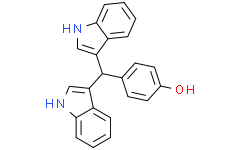| Cas No.: | 151358-47-3 |
| Chemical Name: | 4-(Di(1H-indol-3-yl)methyl)phenol |
| Synonyms: | 4-(di-1H-indol-3-ylmethyl)-Phenol;4-(di(1H-indol-3-yl)Methyl)phenol;DIM-C-pPhOH;4-[bis(1H-indol-3-yl)methyl]phenol;CDIM8;C-DIM8;DIM-C-pPhOH(CDIM8);BCP28949;4-(di-1H-indol-3-ylmethyl)phenol;STK521918;4-[Bis(1H-indole-3-yl)methyl]phenol;Phenol, 4-(di-1H-indol-3-ylmethyl)-;AK431678 |
| SMILES: | O([H])C1C([H])=C([H])C(=C([H])C=1[H])C([H])(C1=C([H])N([H])C2=C([H])C([H])=C([H])C([H])=C12)C1=C([H])N([H])C2=C([H])C([H])=C([H])C([H])=C12 |
| Formula: | C23H18N2O |
| M.Wt: | 338.4018 |
| Sotrage: | 2 years -20°C Powder, 2 weeks 4°C in DMSO, 6 months -80°C in DMSO |
| Description: | DIM-C-pPhOH is a nuclear receptor 4A1 (NR4A1) antagonist. DIM-C-pPhOH inhibits cancer cell growth and mTOR signaling, induce apoptosis and cellular stress. DIM-C-pPhOH reduces cell proliferation with IC50 values of 13.6 μM and 13.0 μM for ACHN cells and 786-O cells, respectively[1]. |
| In Vivo: | DIM-C-pPhOH (30 mg/kg; oral gavage; daily; for 50 days; male athymic nude mice) treatment results in a significant inhibition of tumor growth[1]. Animal Model: Male athymic nude mice (aged 6-7 weeks) injected with ACHN cells[1] Dosage: 30 mg/kg/day Administration: Oral gavage; daily; for 50 days Result: Resulted in a significant inhibition of tumor growth. |
| In Vitro: | DIM-C-pPhOH (7.5-20 μM; 24 hours; ACHN and 786-O cells) treatment significantly decreases cell proliferation[1]. DIM-C-pPhOH (20 μM; 24 hours; ACHN and 786-O cells) treatment induces Annexin V staining in ACHN and 786-O cells, confirming that DIM-C-pPhOH induce apoptosis, and also induces cleavage of caspases 7 and 8[1]. DIM-C-pPhOH (15-20 μM; 24 hours; ACHN and 786-O cells) treatment inhibits NR4A1-regulated expression of survivin, bcl-2 and EGFR in ACHN and 786-O cells. And also induces sestrin 2, activates AMPKα and inhibits activation of mTOR and downstream kinases[1]. DIM-C-pPhOH decreases expression of β1-integrin protein and mRNA and β1-integrin-dependent responses in MCF7, MDA-MB-231, and SKBR3 cells and also inhibits migration of the latter two cell lines[2]. Cell Proliferation Assay[1] Cell Line: ACHN and 786-O cells Concentration: 7.5 μM, 15 μM, 20 μM Incubation Time: 24 hours Result: Significantly decreased cell proliferation. Apoptosis Analysis[1] Cell Line: ACHN and 786-O cells Concentration: 20 μM Incubation Time: 24 hours Result: Induced apoptosis in ACHN and 786-O cells. Western Blot Analysis[1] Cell Line: ACHN and 786-O cells Concentration: 15 μM, 20 μM Incubation Time: 24 hours Result: Inhibited NR4A1-regulated expression of survivin, bcl-2 and EGFR in ACHN and 786-O cells. And also induced sestrin 2, activated AMPKα and inhibited activation of mTOR and downstream kinases. |

 DC Chemicals' products qualify for U.S. tariff exemptions. We guarantee no price increases due to customs duties and maintain stable supply, continuing to deliver reliable research solutions to our American clients.
DC Chemicals' products qualify for U.S. tariff exemptions. We guarantee no price increases due to customs duties and maintain stable supply, continuing to deliver reliable research solutions to our American clients.





















